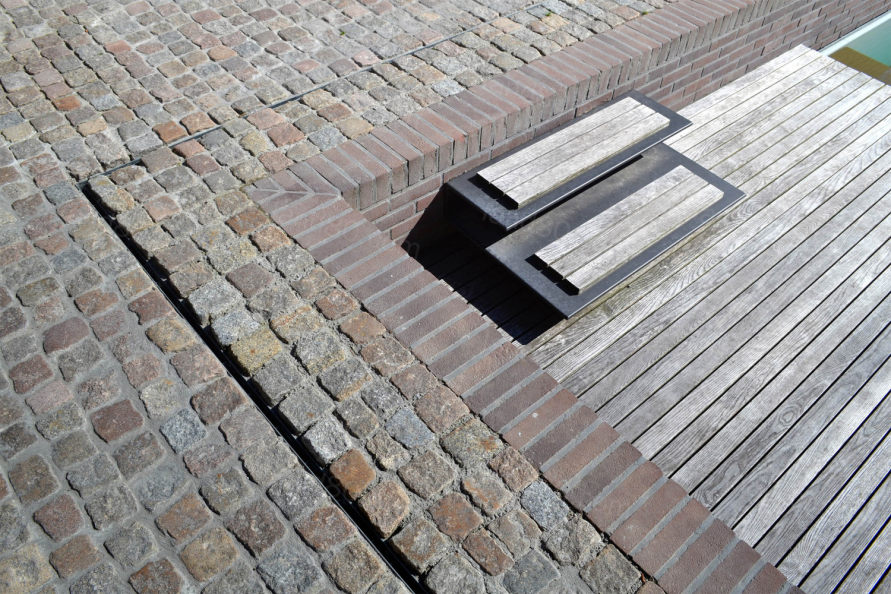古老的森林和开阔的石南花田是荷兰花园的景观的特征。
Old forests and open heather fields characterize the old landscape where this garden is situated.

©Andrew van Egmond
在“黄金时代”时,来自阿姆斯特丹的幸运者在这里建造了乡村庄园。但随着历史的发展,越来越多的有钱人定居在荷兰更高的沙地上,因此原始景观就变成了花园。
In the golden ages, fortunate people form Amsterdam built their countryside estates here. Through the ages more and more people with money settled on these higher sandy grounds of the Netherlands. Parcels became smaller and smaller and the original landscape was turned into gardens.

©Andrew van Egmond
虽然场地是一个非常适合居住的绿色区域,但是与原始景观的联系已经消失了,因此这个私家花园的概念是用一种微妙的方式将原有的景观重新引入,松树和当地的桦树种植在一起,并移植了大量的草地,用极简的长线条勾勒郁郁葱葱的绿色景观。
Although it is a very green area to live in, the connection with the original landscape has been lost. The concept of this garden is to introduce the original landscape back again in a subtle way. Typical Pine and native Birch trees have been selected and planted in a natural composition. One big field of perennial grasses has been introduced and refers to the original landscape. Long minimalistic lines are positioned to frame the lush green clouds of shrubs, trees and grasses.

©Andrew van Egmond

©Andrew van Egmond

©Andrew van Egmond

©Andrew van Egmond
此外,项目内选择的材料都与自然亲和,并能与古典建筑相呼应:所用的砾石类型在荷兰很典型,在这种环境下感觉很自然,花岗岩鹅卵石也很有意义,因为它们是旧花园里剩下的材料。
The chosen materials have a humble appearance and accommodate the classical architecture. The type of gravel used is typical for The Netherlands and feels very natural for this environment. The granite cobble stones are meaningful because they are a relict from the old garden.

©Andrew van Egmond

©Andrew van Egmond

©Andrew van Egmond

©Andrew van Egmond

©Andrew van Egmond
精致的细节是精心设计的关键,木制平台的设计方式就是一个很好的例子,它似乎漂浮在墙壁、路面、草坪和游泳池的上方;为了防止游泳池在这个自然环境中显得格格不入,我们选择用混凝土墙来建造。
Refined detailing is key for a minimal design approach. The way the wooden deck is designed is a good example of this. It appears to be floating above the walls, paving surfaces, lawn and swimming pool. To prevent the pool from seeming alien in this natural setting, concrete walls were chosen to achieve an appealing green look.

©Andrew van Egmond

©Andrew van Egmond

©Andrew van Egmond

©Andrew van Egmond
私家花园应该是住宅的人类尺度和景观的更大尺度之间的联系。在这个花园中,这是通过极简主义的线条来实现的,它在后面形成了郁郁葱葱的绿色,并将前面的草坪变成了一片大的多年生草地。野草和多棵树干的野生外观与经典的房子形成了美丽的对比,多年生草地是一幅捕捉风、雨、霜、阳光等元素的活画,它是一种不断变化的构图,将我们与季节和情感联系在一起,这是普通生活体系结构中无法期望的体验。
The garden should be a link between the human scale of the dwelling and the larger scale of the landscape. In this garden, this is realized by introducing a long minimalistic line in the back framing the lush green and by transforming the front lawn into one big field of perennial grasses. The wild look of the grasses and multi-trunk trees make a beautiful contrast with the classic house. The field of perennial grasses is a living painting capturing the elements of wind, rain, frost and sunlight. It is an ever changing composition which connects us to the seasons and our emotions. An experience you don’t expect with this type of architecture.

©Andrew van Egmond

©Andrew van Egmond

©Andrew van Egmond

©Andrew van Egmond

©Andrew van Egmond

©Andrew van Egmond

©Andrew van Egmond
▼项目平面图

项目名称:Field emotions
设计师:Andrew van Egmond
项目位置:荷兰 阿姆斯特丹
草地种植:Kroeze Hoveniers Beesd
树木种植:Van der berk
照明:Burlight
建筑翻新与泳池建造:BOS architects
室内设计:De Brouwer Binnenwerken
照片来源:Andrew van Egmond
Designer: Andrew van Egmond
Photography: Andrew van Egmond
Green constructor: Kroeze Hoveniers Beesd
Trees by: Van der berk
Lighting by: Burlight
Architect renovation and pool: BOS architects
Interior architect: De Brouwer Binnenwerken
|